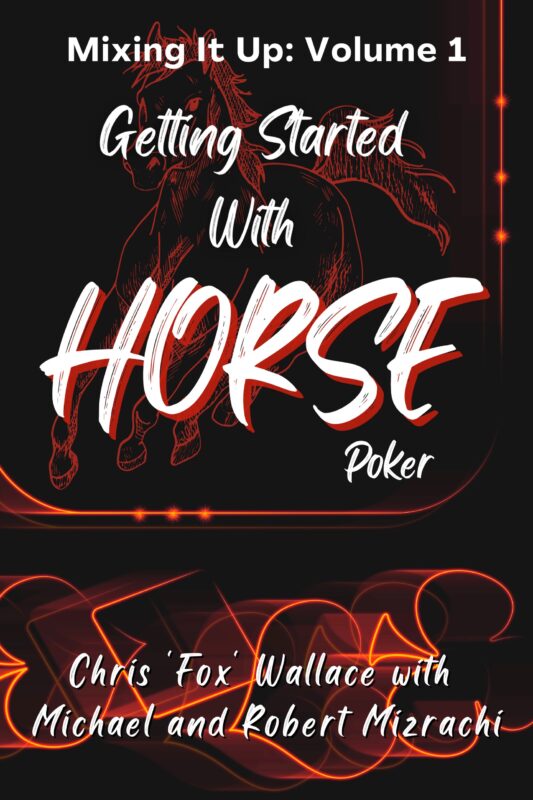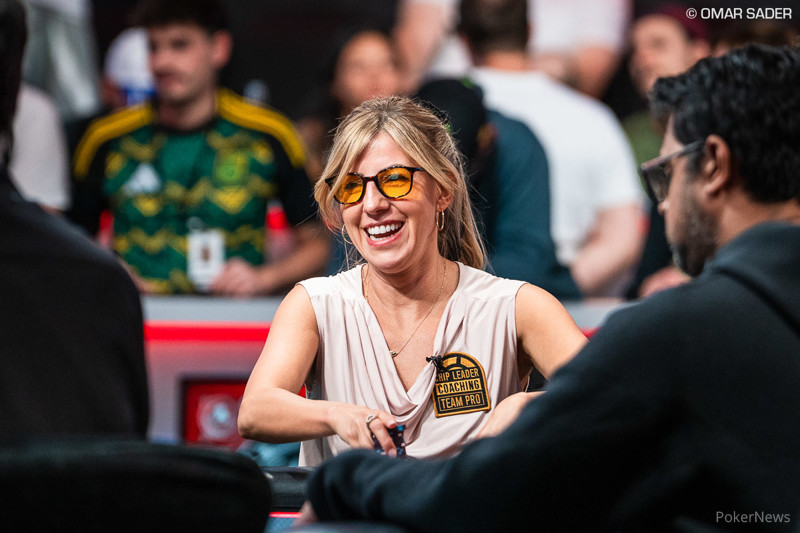In recent years, mixed games have become an increasingly overlooked segment of the pokersphere. But, talk to the pros and they’ll tell you that to be considered among the best players in the game, you need to have an understanding — and, ideally, a mastery of a number of games other than No-Limit Hold’em.
To that end, CardsChat contributor Chris “Fox” Wallace, along with brothers Michael and Robert Mizrachi, has written a guide on how to approach HORSE (Hold’em, Omaha Hi/Lo, Razz, Stud, Stud Hi/Lo 8 or Better), one of the most popular mixed-game variants found in poker rooms around the globe.

The book has received excellent reviews on Amazon, and deservedly so, with three world champions and $27 million in combined tournament winnings behind it. The chapter on pot odds starts out a bit … odd … but by the end, readers will have learned to think about the game differently and also made friends with a talking horse. You can buy the book on Amazon and read an excerpt below.
Learning Pot Odds From a Talking Horse
Fixed-limit poker is a game of pot odds. While guts, intuition, and well-timed aggression can take you a long way in the no-limit games, you’ll need a different set of skills to beat fixed-limit games. You need to understand how pot odds work if you’re going to crush HORSE games.
You’ve probably heard the term pot odds and may even have a basic understanding of what we mean when we use that term, but a surprising number of players have never really learned how they work. The good news is that there is a fairly simple way to calculate and understand pot odds. Let’s start with a definition of the term itself.
The basic definition, written about in hundreds of strategy articles over the years, is that pot odds are the odds you’re getting from the pot when you’re facing a bet. But being offered odds by the pot? That’s a strange concept for a beginning player. It’s easier if you remember that being offered odds works the same way no matter who, or what, is offering them.
Pot to Price
We typically express pot odds as the size of the pot, including any bets that are committed to the pot, “to” the cost of the call. So when someone bets $50 into a $100 pot, the pot is now $150. They can’t take the $50 bet back, so it’s part of the pot now even if it hasn’t been pulled in by the dealer yet. And the cost to call is $50, so the pot odds are $150 to $50, or 3 to 1. The pot is 3, the price is 1, so pot to price is 3 to 1. Remember “pot to price” as the way we talk about these things.
Making a Very Odd Friend
Let’s say you meet a talking horse. Why a talking horse? Because it’s easy to remember and this is a book about HORSE. Now this talking horse loves to gamble, but he doesn’t understand anything about odds because horses are not good at that kind of thing. He starts to offer you gambling propositions.
“Let’s flip a coin,” he says. “You call it. And you flip the coin because I only have hooves. If you get it right, I’ll pay you $10. If you’re wrong, you pay me $5”
Should you take him up on his offer? Unless it’s your last $5 and you need it to eat, or you don’t think he can pay you because horses don’t have pockets, you should definitely take this bet. Because you’re getting $10 to $5, or 2-to-1 odds, on an even money, or 1-to-1, proposition.
Now the horse starts to offer more gambling opportunities. When he offers to roll a standard six-sided dice and pay you 4-to-1 if you guess the number correctly before the roll, you have to calculate the odds of winning against what he is paying you. You will guess the number correctly one time for every five times that you get it wrong, but he will only pay you four dollars for each correct guess. You’re getting 4-to-1 on a 5-to-1 chance, which means that you’re losing money.
As long as you turn down the bad gambles and only take the good ones, you can win money from this dumb horse all day long. It’s a very simple gambling opportunity, and easy to understand, which is why it’s the perfect way to explain pot odds.
To win all the horse’s money, you just need to take his offers when he offers odds that are higher than your odds of winning. And how does this apply to pot odds? That is the beauty of it. This IS pot odds. The horse IS the pot.
“I have to stop gambling with you for now,” says the horse. “Because I’m also a poker dealer at the card room next door and my shift is about to start.” Not only can this horse talk, but he can also deal poker? Incredible!
You have made a few hundred dollars from the horse by this time and decide to take your winnings to the card room and play some poker. The opportunity to watch a horse deal poker is just too good to pass up.
The Horse Offers Pots Instead of Bets
You sit down to play, and the horse is the dealer. The game is $1/2 no-limit Holdem. On your first hand you’re dealt the king-five of diamonds in the big blind. A player raises to $5, and everyone folds to you. You call to see a flop.
When the horse drags the money into the pot there is $5 from the original raiser, $5 from your call, and $1 from the small blind. There is no rake in this game. So the pot is $11, which the horse will award to you if you win the hand.
The original raiser only has another $2 left in front of him. No, I don’t know why he didn’t go all-in preflop. A talking horse is dealing the game, so a player betting all but $2 of his stack is really not that absurd compared to the rest of the story.
The flop is 2d 6d Ts giving you a flush draw. You check. The original raiser goes all-in for his last $2 and then flips over two black aces before you get a chance to act on his bet. Now what should you do?
This proposition is no different than any of the other bets the horse offered you. He will award you a pot that now contains $13 if you win the hand, and you will lose $2 if you lose the hand. So you’re getting 13-to-2 odds from the horse. That part is easy to figure out, and that is what we mean when we say “pot odds.”
The idea that the pot is just money you can win, it doesn’t matter where it came from, makes pot odds an easy thing to understand. Just remember “pot to price.”
The Definition of Pot Odds
Since the horse is offering you the odds, you could call them horse odds instead, because pot odds can be a confusing term and it is used, and misused, in so many different ways. But the real definition of pot odds is:
“Odds you’re receiving from the pot (or talking horse) when facing a bet.”
How can a pot offer odds? The same way a horse does. You can always think of the horse, or the poker dealer, offering you the opportunity to gamble if it seems less complicated that way. Just picture the dealer offering the odds to win the pot as if you’re playing against the house.
But what many poker players mean when they say “pot odds” is really the odds you’re getting from the pot compared to your odds of winning. The horse odds if you will. This is where we find a lot of confusion. Because there are different things people are talking about when they say “pot odds.”
Knowing that you’re getting 13-2 odds on your flush draw doesn’t help you if you don’t know how often you will win. This is like the horse offering you 10-to-1 if you can predict the number a dice will land on, but not telling you how many sides are on the dice. You need to know your odds of winning before you make your decision.
There are a couple of simple methods for figuring out how often you will win a hand. We start by counting “outs”, which are cards that will make your hand a winner. Think of each card that makes your hand a winner as a way “out” of losing the hand. This is why some players say that “you need to know your odds and outs” to win.
To simplify this hand we’ll ignore other possibilities, and just assume that making your flush is the only way you can win. That means that your “outs” are all the remaining diamonds. They are your only way “out” of losing to the two black aces.
Since we can see four diamonds, two on the board and two in your hand, and your opponent doesn’t have a diamond, there are nine diamonds left in the deck. Nine cards of the remaining forty-five will win you the pot, and you get two chances, the turn and the river.
Knowing how many cards will make you a winner is simple, but it’s not enough to make your decision. You need to know how often you will win. There are two common ways to know your odds of winning in a situation like this. I’ve presented them both below. Use whichever makes the most sense to you.


